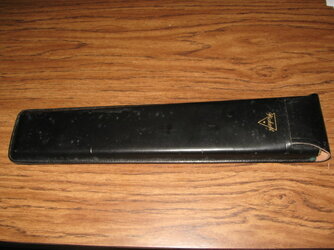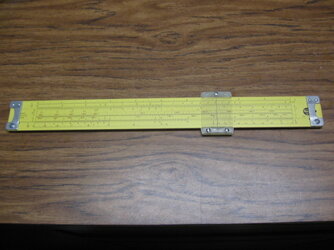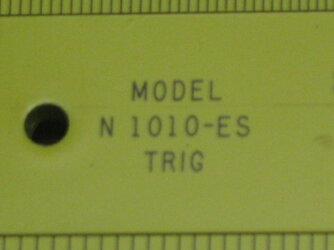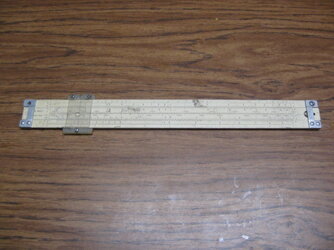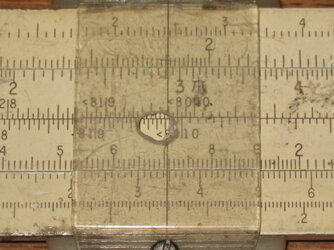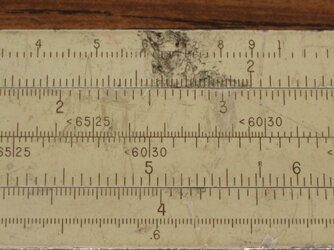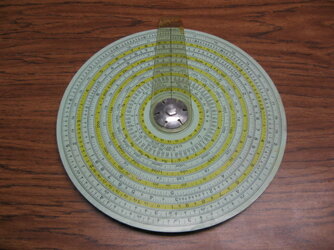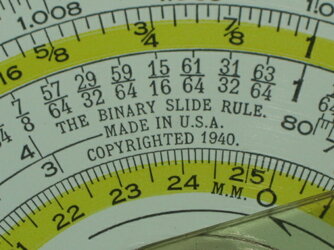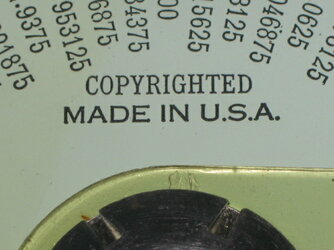Only in pictures. But having one would be cool I think!Anyone remember the giant demonstrator slide rules that hung atop blackboards in high school classrooms?
You are using an out of date browser. It may not display this or other websites correctly.
You should upgrade or use an alternative browser.
You should upgrade or use an alternative browser.
Anyone here use slide rules back in the day?
- Thread starter Rusty Blade
- Start date
Found another one! A Pickett Trig model, 12" aluminum, 1959 copyright date. Immaculate condition, with leather case. Paid $1.50. 
Didn't need another one but for so little I couldn't leave it there. Maybe I should start selling some?

Didn't need another one but for so little I couldn't leave it there. Maybe I should start selling some?
Attachments
Last edited:
I used one in high school. I thought I would become an electrical engineer, but felt God was calling me to become a pastor, instead. About ten years ago I bought a better used Dietzgen rule on eBay for $2.50. Since, a widow gave me the nice K & E rule that her engineer husband had used. Both needed a little repair.
Werner von Braun was head of the US efforts in the Space Race. Sergei Korolov was the head of the Soviet efforts in the Space Race. Both used a Nestler 23 slide rule, although von Braun also had an even better rule. The Nestler 23 was made from wood and had the same basic scales as my Pickett 120 plastic trainer rule from high school.
There are new old stock rules for sale on some slide rule pages on the Internet. There are many used rules in all conditions for sale on eBay. You can also download original manuals for most slide rules.
Scientific American had an interesting article titled “When Slide Rules Ruled” that appeared in the May 2006 issue. I found a free copy of the article to download.
(I did not realize how old this thread is, and posted some of this earlier, but not all of it.)
Werner von Braun was head of the US efforts in the Space Race. Sergei Korolov was the head of the Soviet efforts in the Space Race. Both used a Nestler 23 slide rule, although von Braun also had an even better rule. The Nestler 23 was made from wood and had the same basic scales as my Pickett 120 plastic trainer rule from high school.
There are new old stock rules for sale on some slide rule pages on the Internet. There are many used rules in all conditions for sale on eBay. You can also download original manuals for most slide rules.
Scientific American had an interesting article titled “When Slide Rules Ruled” that appeared in the May 2006 issue. I found a free copy of the article to download.
(I did not realize how old this thread is, and posted some of this earlier, but not all of it.)
Last edited:
I got a TI calculator for a graduation present from HS-1974. It was novel enough that one of the doctors I worked with (summer job at MD Anderson) would borrow it to do calculations. Weird how much technology has changed for us boomers in our lifetime. I never used a slide rule that I can recall.
I found a downloadable version of that article here. Nice! :
Also a lengthy (91 pages) explanation of the slide rule here:
Also a lengthy (91 pages) explanation of the slide rule here:
OMG....haven't used one for maybe 45-50 years...Had a small one that fit into the breast pocket of the lab coat and a long one on the desk. A slide ruler and a logarithm table was all we were allowed to use in all our tests. Pocket calculators just appeared in, I think 1973/74 or so. They had just the four basic functions (= - X /) and cost a fortune. One of my colleagues who was a year under me bought one, at the time it was 375 Deutsche Mark. I got my first in 1975, and it was one of the first scientific ones, cost also a fortune. Problem with this one was that it ran on four AAA batteries, which at this time were quite rare in Germany and also cost a lot of money. I think I spend some $40 a month on batteries when I started to study at night college.
Another relic, grabbed just for parts (as it's got issues - missing screws, broken cursor and spring, plus dirty and damaged front scale). But then discovered it's a 1949 Pickett magnesium model N902-T Simplex Trig. So I'm going to try and gently clean and repair it.
Attachments
I am a Commercial/Multi-engine/Instrument pilot and I still use a slide rule. In aviation it is circular and called an E6B. For flying I wear a Breitling Navitimer watch which has an E6B slide rule on the bezel. The aircraft I fly have Garmin GTN650 computers that do pretty much everything better than a slide rule or calculator does, but there are a few calculations such as time to the next waypoint and decent times that for me that are fast - and fun - on the E6B slide rule.
Cool!I am a Commercial/Multi-engine/Instrument pilot and I still use a slide rule. In aviation it is circular and called an E6B. For flying I wear a Breitling Navitimer watch which has an E6B slide rule on the bezel. The aircraft I fly have Garmin GTN650 computers that do pretty much everything better than a slide rule or calculator does, but there are a few calculations such as time to the next waypoint and decent times that for me that are fast - and fun - on the E6B slide rule.
There are sites on the Internet where you can order original parts for many slide rule models. Once I knew the name of one I used for a Keuffel & Esser rule a widow gave me after her engineer husband had died. The parts supplied are taken from original slide rules too damaged for restoration. They are not newly manufactured.Another relic, grabbed just for parts (as it's got issues - missing screws, broken cursor and spring, plus dirty and damaged front scale). But then discovered it's a 1949 Pickett magnesium model N902-T Simplex Trig. So I'm going to try and gently clean and repair it.
10-4 I can probably find a cursor and spring if the clean-up goes well enough, but the cost might make it not cost effective. We'll see.There are sites on the Internet where you can order original parts for many slide rule models. Once I knew the name of one I used for a Keuffel & Esser rule a widow gave me after her engineer husband had died. The parts supplied are taken from original slide rules too damaged for restoration. They are not newly manufactured.
Yes! Over the years I've used slide rules, pocket calculators, computers and pencil/pen and paper. I majored in math, physics, electrical engineering, and law. A few years ago, maybe 10 or 15 years ago, I thought I really should be familiar with the abacus. I can't say I'm proficient, but at least I understand how to add and subtract with it. So now I have 3 abaci - a Chinese one, bought in Chinatown, a Japanese one (soroban) which I mail ordered, and a vintage Chinese one bought on eBay. AFAIK, they still use and teach the abacus in China.It's easy to see why calculators have taken over the world. We really dont need to know how to think.
Anyone out there use an abacus?
I also have 2 slide rules and 3 HP pocket calculators.
A few years ago, I taught mathematics in a Community College. We had a lesson on logarithms and exponents. I tried to show the class how you could multiply using a table of logarithms and antilogarithms. Yawn. No interest.
I played with one, but I didn’t solve any problems.
I am by no means an expert with a rule, but once a week I use it to calculate my gas mileage just to stay in practice. One 90 year old rule I have has a handy conversion chart built into the back of it. Kilometers to miles, cubic inches to cc's, stuff like that. When China cuts off our battery supply it'll come in handy!I played with one, but I didn’t solve any problems.

Found another one!
A circular binary type of rule. 8" diameter, aluminum main body with 3 arm cursors, a bit unusual but I think once mastered it will be easier to use than a linear style. Numbers are bigger, too. Faux leather carry case and user manual included! Cost me $2.
A circular binary type of rule. 8" diameter, aluminum main body with 3 arm cursors, a bit unusual but I think once mastered it will be easier to use than a linear style. Numbers are bigger, too. Faux leather carry case and user manual included! Cost me $2.
Attachments
It is a bit unusual from a regular slide rule. Here is a description of its scales.Found another one!
A circular binary type of rule. 8" diameter, aluminum main body with 3 arm cursors, a bit unusual but I think once mastered it will be easier to use than a linear style. Numbers are bigger, too. Faux leather carry case and user manual included! Cost me $2.
In college it was either a slide rule or nuthin' since calculators in the early 70's could only add, subtract, multiply, divide and eat batteries. Dad got me a TI, which spent much of its' career in the box.
My favorite slide rule was a circular model that fit my shirt pocket the best. It's still somewhere on my desk.
I also have a Mitutoyo Dial Micrometer that was my Dad's & gets more use than the digital models that always seem to have dead batteries.
A Starrett #113 Micrometer is also on my desk - my former Father-in-Law pulled it from a junk box in the R&D Lab at Lincoln Electric back in the late 1970's. I spent several hours removing the crud & rust from it & it's no beauty. But it's always there when I need it.
My favorite slide rule was a circular model that fit my shirt pocket the best. It's still somewhere on my desk.
I also have a Mitutoyo Dial Micrometer that was my Dad's & gets more use than the digital models that always seem to have dead batteries.
A Starrett #113 Micrometer is also on my desk - my former Father-in-Law pulled it from a junk box in the R&D Lab at Lincoln Electric back in the late 1970's. I spent several hours removing the crud & rust from it & it's no beauty. But it's always there when I need it.
Yep, EMP proof, no batteries needed, theft-resistant, and keeps the brain in shape. Best of all worlds!In college it was either a slide rule or nuthin' since calculators in the early 70's could only add, subtract, multiply, divide and eat batteries. Dad got me a TI, which spent much of its' career in the box.
My favorite slide rule was a circular model that fit my shirt pocket the best. It's still somewhere on my desk.
I also have a Mitutoyo Dial Micrometer that was my Dad's & gets more use than the digital models that always seem to have dead batteries.
A Starrett #113 Micrometer is also on my desk - my former Father-in-Law pulled it from a junk box in the R&D Lab at Lincoln Electric back in the late 1970's. I spent several hours removing the crud & rust from it & it's no beauty. But it's always there when I need it.

I had a Post slide rule in high school in the sixties. I wore it on my belt in a leather case. I looked like Josh Randall bounty Hunter. (Steve McQueen in Wanted Dead or Alive). I remember the Bomar Brain 4 function calculator. Very expensive. I used a TI hex, HP that did hex and octal, and an HP scientific with no parentheses function and then got spoiled with a TI that had parentheses.
I used a small circular slide rule all through high school. Owned an early scientific calculator then but they weren't allowed on test as not every student could afford one. Once in college I relied on my calculator. Have a nice Picket trig and loglog slide rule that was a gift a few years prior to college that looks nice in my office to this day though it was rarely used.
Learning math on the slide rule really helped develop an intuitive sense of numbers that has been beneficial to this day. See too many situations where a calculator or software is now used without the user really understanding the numbers. Was happy to see my son's HS math teacher limit calculator use to force development of that type of understanding. Today's graphing calculators and available software such as Desmos, Geogebra or Wolfram can even solve the symbolic equations in advanced math courses.
Learning math on the slide rule really helped develop an intuitive sense of numbers that has been beneficial to this day. See too many situations where a calculator or software is now used without the user really understanding the numbers. Was happy to see my son's HS math teacher limit calculator use to force development of that type of understanding. Today's graphing calculators and available software such as Desmos, Geogebra or Wolfram can even solve the symbolic equations in advanced math courses.
Guilty as charged. I tell people it is a solar calculator; if I can see it I can use it.
